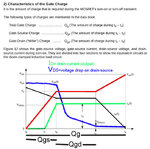Wamor
Junior Member level 2
Hello,
I am using a IR4426 mosfet-driver to switch a IRFR3910 mosfet.
The IR4426 mosfet-driver has a Io+/- of 1.5A.
The IRFR3910 mosfet has a Qg of 44nC (Qgs = 6.2nC and Qgd = 21nC).
If I do not use any gate resistor I learned that I can calculate the mosfet-switch-on time by the following formula: t = Qg / Io which gives me a switch-on time of 29.3ns. Is this correct?
Is the IR4426 always supplying 1.5A also when I use a mosfet which doesn't require a current of 1.5A?
What will be the influence of a gate-resistor with regards to the switch-on time?
How do I calculate the correct gate-resistor.
Thank you and best regards
I am using a IR4426 mosfet-driver to switch a IRFR3910 mosfet.
The IR4426 mosfet-driver has a Io+/- of 1.5A.
The IRFR3910 mosfet has a Qg of 44nC (Qgs = 6.2nC and Qgd = 21nC).
If I do not use any gate resistor I learned that I can calculate the mosfet-switch-on time by the following formula: t = Qg / Io which gives me a switch-on time of 29.3ns. Is this correct?
Is the IR4426 always supplying 1.5A also when I use a mosfet which doesn't require a current of 1.5A?
What will be the influence of a gate-resistor with regards to the switch-on time?
How do I calculate the correct gate-resistor.
Thank you and best regards
